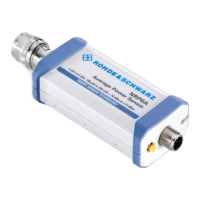Remote Control - Fundamentals R&S NRP
1144.1400.12 5.8 E-3
This command sets the number of timeslots in the Timeslot mode to 6. The
following command has the same effect. :POWer:TSLot:COUNt 6
Note: An optional keyword cannot be omitted if its effect is specified in more detail
by a numeric suffix.
Example: SENSe2:POWer:TSLot:COUNt 6 in short form:
SENSe2:POWer:TSLot:COUNt 6
Long and short
form
The keywords have a long and a short form. The keyword may be entered in short
or in long form; other abbreviations are not allowed. The short form uses the first
four characters of the long form. If the fourth character is a vowel and the long
form consists of more than four characters, only the first three characters are used
for the short form. The short form is shown by upper-case characters, and the long
form is the entire keyword.
Example: STATus:QUEStionable:ENABle 1 and STAT:QUES:ENAB 1
Note: Upper- and lower-case letters are only used for
identifying the long and short form in the manual; the
device itself does not differentiate between the two types
of characters.
Parameters
The parameter must be separated from the header by a white space. If a
command contains several parameters, they have to be separated by a comma
(,). Some of the commands allow the specification of the parameters
MINimum,
MAXimum and DEFault. For a description of the parameter types see
Æ section Parameters, page 5.11.
Example: SENSe1:TIMing:EXCLude:STARt? MINimum
Response: 0
This query asks for the minimum setting value.
Numeric suffix
If a device has several identical functions or features, e.g. inputs, the desired
function can be selected by a suffix to the command. Commands without a suffix
are interpreted as having a suffix of 1.
Example: SENSe2:FUNCtion "POWer:AVG"
This command sets the measurement mode of sensor 2 to the ContAv mode

